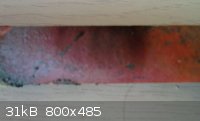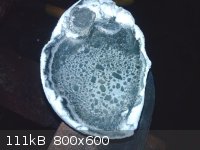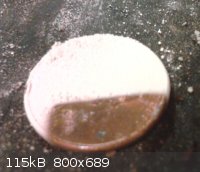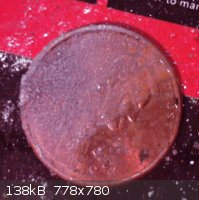m1tanker78
National Hazard
   
Posts: 685
Registered: 5-1-2011
Member Is Offline
Mood: No Mood
|
|
Violet colored copper compound?
I hate asking such broad questions but I've never seen it before and I can't find any info on the net regarding a violet or purple colored copper
compound. I was conducting some experiments with NaH and left a copper clad carbon electrode close to the heating vessel. This wasn't part of the
experiment, BTW. The part that was closer to the NaH turned violet and the part that was further turned bright-ish orange (copper(I) oxide, I assume).
I tried to take pics but my phone camera sucks.
Maybe very thin layers of red oxide and blue ammonia/Cu-like deep blue? No NH3 nor the hydroxide anywhere near, though. Unless the hot H released by
the NaH reacted with atmospheric nitrogen to produce a very small amount of NH3? During the experiment, I adjusted the NaH's temp to keep it under the
point where the H would spontaneously ignite. It was done in open air - no external inert atm.
I should probably leave this alone and get back on track but I'm very curious about this.
Tom
[Edited on 3-2-2011 by m1tanker78]
|
|
|
m1tanker78
National Hazard
   
Posts: 685
Registered: 5-1-2011
Member Is Offline
Mood: No Mood
|
|
This is the best I can do at the moment. The dark part in the middle is where I held it over the torch flame.

Tom
|
|
|
hkparker
National Hazard
   
Posts: 601
Registered: 15-10-2010
Location: California, United States
Member Is Offline
Mood: No Mood
|
|
I have made a violet copper compound, its copper in the +3 oxidation state, though I dont know if thats what you have here.
http://81.207.88.128/science/chem/exps/CuIII/index.html
http://www.youtube.com/watch?v=rehrlU-9bi8
My YouTube Channel
"Nothing is too wonderful to be true if it be consistent with the laws of nature." -Michael Faraday
|
|
|
m1tanker78
National Hazard
   
Posts: 685
Registered: 5-1-2011
Member Is Offline
Mood: No Mood
|
|
Thanks for the link; nice vids! There isn't much out there that describes Copper (III) compounds and colors. Although the substrate looks crappy, that
color is wild on copper. Imagine having a pocket full of violet pennies... hehe
I was hoping woelen would weigh in; he's done some work with copper not too long ago.
Tom
|
|
|
hkparker
National Hazard
   
Posts: 601
Registered: 15-10-2010
Location: California, United States
Member Is Offline
Mood: No Mood
|
|
Yea that first link is from woelen's site, hes done some great work there!
My YouTube Channel
"Nothing is too wonderful to be true if it be consistent with the laws of nature." -Michael Faraday
|
|
|
woelen
Super Administrator
        
Posts: 7976
Registered: 20-8-2005
Location: Netherlands
Member Is Offline
Mood: interested
|
|
You will also like the copper experiment in this:
http://woelen.homescience.net/science/chem/exps/raw_material...
It really is purple. The only truly purple compound of copper which I know of.
The most funny thing is that this experiment does not require special chemicals. Just copper sulfate and Na-DCCA (a common swimming pool chlorinator,
shock treatment).
[Edited on 29-4-11 by woelen]
|
|
|
m1tanker78
National Hazard
   
Posts: 685
Registered: 5-1-2011
Member Is Offline
Mood: No Mood
|
|
@hkparker: I overlooked the first link you posted (the one to woelen's work). I watched a few of your youtube videos. Nice work!
@woelen: Your website was an unexpected treasure chest. Your experiment has provided me a lot of insight. I also came across one of your old posts on
here where polverone obtained purple Cu compound. It's mentioned and there's a photo about halfway down the first page....
http://www.sciencemadness.org/talk/viewthread.php?tid=5686
Tom
|
|
|
hkparker
National Hazard
   
Posts: 601
Registered: 15-10-2010
Location: California, United States
Member Is Offline
Mood: No Mood
|
|
Thank you, I'm glad to know you enjoyed my videos!
My YouTube Channel
"Nothing is too wonderful to be true if it be consistent with the laws of nature." -Michael Faraday
|
|
|
m1tanker78
National Hazard
   
Posts: 685
Registered: 5-1-2011
Member Is Offline
Mood: No Mood
|
|
I was able to reproduce what happened the other day with a new copper clad carbon rod. By altering the conditions, I was able to produce a few
different compounds. One of them was ammonia (or some ammonia compound that smells like ammonia gas). Another was NaNO3. That was a shock to me but
don't know of any other white powdery Na compounds that smell sweet. Reminds me of KNO3 but I didn't use any K compounds anywhere near the experiment.
During this procedure, a glassy or ceramic-like carbon compound also forms. More than likely a mixture of fused carbonate and free carbon? I was sure
much higher temps were needed to free carbon from sodium carbonate but then again, if the Na cation is forcefully stripped off then .... who knows.
Some NaH also forms during the procedure (depending on the circumstances). I have no doubt that it's highly impure since it reacts anywhere from slow
but steady to vigorously with water and releases hydrogen. It has absolutely no odor to it when dry but gives water the typical hydroxide stench after
a little while. Same goes if it's left sitting out.
Sorry for rambling! I should have been asleep 3 hours ago. So which of the above compounds is likely to change Cu to the +3 oxidation state?? It has
to be between the ammonia compound and the nitrate, in my opinion anyway.
I'll post some pics tomorrow...
Tom
|
|
|
woelen
Super Administrator
        
Posts: 7976
Registered: 20-8-2005
Location: Netherlands
Member Is Offline
Mood: interested
|
|
What did you do in your experiments? You made NaNO3, NaH, stripped carbon from carbonate and other fancy things?
Could you please give a full description of your experiments? I doubt that you made any of the above mentioned compounds and stripping carbon out of
carbonate ion also sounds very unlikely to me. I (or others) may be able to explain your observations.
So, your descriptions should mention
- compounds used in your experiments
- if electrolysis, then also describe voltage, anode and cathode
- situation before starting the reaction
- situation after the reaction (include colors, formation of precipitates, gases, change of color of electrodes, etc.).
|
|
|
m1tanker78
National Hazard
   
Posts: 685
Registered: 5-1-2011
Member Is Offline
Mood: No Mood
|
|
Quote: Originally posted by woelen  | What did you do in your experiments? You made NaNO3, NaH, stripped carbon from carbonate and other fancy things?
Could you please give a full description of your experiments? I doubt that you made any of the above mentioned compounds and stripping carbon out of
carbonate ion also sounds very unlikely to me. I (or others) may be able to explain your observations.
So, your descriptions should mention
- compounds used in your experiments
- if electrolysis, then also describe voltage, anode and cathode
- situation before starting the reaction
- situation after the reaction (include colors, formation of precipitates, gases, change of color of electrodes, etc.). |
You're probably right; and I'm sure most or all of the carbon comes from electrode erosion. But it does form an interesting (visually appealing)
ceramic-like skin together with what I presume to be carbonate on the sub-surface of the melt. The copper effects above the melt are a treat too.
These experiments are in their infancy (to me) so any clues would be a big help. If it's ok with you, I'd rather PM you the details or gather more
info and start a new thread.
Tom
|
|
|
woelen
Super Administrator
        
Posts: 7976
Registered: 20-8-2005
Location: Netherlands
Member Is Offline
Mood: interested
|
|
Feel free to PM me, but for the sake of getting more response I would open a new thread and provide detailed info in that thread. Others probably are
interested as well.
|
|
|
m1tanker78
National Hazard
   
Posts: 685
Registered: 5-1-2011
Member Is Offline
Mood: No Mood
|
|
I'm not sure why there's such a pronounced dark band above the violets. The rest of the spectrum is almost certainly a temperature gradient. Other
than NaNO3, is there any other Na compound that has a sweet smell to it? Whatever it may be, it's not directly related to the below pic because it was
produced at the cathode.

Tom
|
|
|
m1tanker78
National Hazard
   
Posts: 685
Registered: 5-1-2011
Member Is Offline
Mood: No Mood
|
|
This is the ceramic-like material I mentioned earlier. It's from a previous small-scale experiment. It's light and 'tings' if I tap it lightly. It's a
little fragile so it will crack if dropped on the floor, for example. Once again, the pic doesn't do it justice but it's nice to look at - even if
it's nothing more than glass with carbon(?) impurity.

Tom
|
|
|
wpenrose
Harmless

Posts: 17
Registered: 17-6-2007
Member Is Offline
Mood: No Mood
|
|
Quote: Originally posted by m1tanker78  | I hate asking such broad questions but I've never seen it before and I can't find any info on the net regarding a violet or purple colored copper
compound. I was conducting some experiments with NaH and left a copper clad carbon electrode close to the heating vessel. This wasn't part of the
experiment, BTW. The part that was closer to the NaH turned violet and the part that was further turned bright-ish orange (copper(I) oxide, I assume).
|
Could it be interference effects, like those seen on titanium and niobium when oxide layers are formed electrolytically? IF so, there would be a
gradual variation in color over the electrode as the layer thickness changed.
There are some violet copper minerals. The nearest I could find online is azurite:
http://en.wikipedia.org/wiki/Azurite
DB
Edit: Your photo suggests layer thickness effects.
[Edited on 3-5-2011 by wpenrose]
|
|
|
m1tanker78
National Hazard
   
Posts: 685
Registered: 5-1-2011
Member Is Offline
Mood: No Mood
|
|
wpenrose, I think it has more to do with the differing rate of reaction(s) due to the temperature variations as you go up.The voilet part is now
turning bright green with the high humidity. The rest appears to be unaffected (for now).
Tom
|
|
|
m1tanker78
National Hazard
   
Posts: 685
Registered: 5-1-2011
Member Is Offline
Mood: No Mood
|
|
Sorry to bump this thread. I didn't want to start a new one...
The sweet smell I mentioned above isn't nitrate but likely some heavy halogenated carbon compound. I had no idea until just the other day that
chloroform and carbon tetrachloride had a sweet smell.
Back to the topic. Which of the following substances are capable or more likely to push Cu to +3?...
* CCl4, C2Cl6, chloroform or similar
* Atomic oxygen radicals
* Molecular oxygen
* Ozone
Keep in mind that these substances are very hot near the surface of the bath and there could be any combination of them at a given time.
At this point, I only have a very basic understanding of oxidation states and electron configurations so forgive me if this seems like a stupid
question. I have a lot of reading to do.... 
Tom
|
|
|
woelen
Super Administrator
        
Posts: 7976
Registered: 20-8-2005
Location: Netherlands
Member Is Offline
Mood: interested
|
|
Maybe oxygen radicals could do this. At the hot surface I do not believe there is any ozone, because that is too unstable.
The purple color could also be due to the presence of small amounts of manganese. Only 0.01% of Mn already leads to a deep purple color if
permanganate is formed.
|
|
|
bahamuth
Hazard to Others
  
Posts: 384
Registered: 3-11-2009
Location: Norway
Member Is Offline
Mood: Under stimulated
|
|
Working with blacksmithing as a hobby, playing with annealing of copper to make it very malleable I have seen that copper compound before, it is just
the optical properties of the oxide/reduced copper that looks like that. In doubt, try to heat copper red hot and keep it in a reducing atmosphere,
in a forge or similar and the violet color will appear.
Any sufficiently advanced technology is indistinguishable from magic.
|
|
|
m1tanker78
National Hazard
   
Posts: 685
Registered: 5-1-2011
Member Is Offline
Mood: No Mood
|
|
Woelen, the only reason I wrote in O3 is because the voilet color occurs only close to the surface and as the anode is eroded, it begins to arc before
I adjust the depth. But like you say, most likely free oxygen can be credited for the purple copper. Refering to your copper(III) experiment, could
NaDCCA be substituted with, let's say, hexachloroethane or similar?
Bahamuth: I've done that before and ended up with the characteristic salmon (pink) color of Cu that's free from oxides. One wants to choke as much
oxygen as possible in the forge to prevent formation of scale and achieve a stronger weld. Copper(III) oxide must be obtained in an oxidizing
atmosphere. In my case, free oxygen radicals combined with high heat are making it happen.
At least that's the standing theory at the moment.
Tom
|
|
|
woelen
Super Administrator
        
Posts: 7976
Registered: 20-8-2005
Location: Netherlands
Member Is Offline
Mood: interested
|
|
First a correction. The experiment with Na-DCCA which I posted here most likely is not a copper(III) experiment. It most likely is just a copper(II)
precipitate of the dichloroisocyanurate ion or some basic version of this precipitate.
A true copper(III) complex I also prepared, a link to that experiment was posted in the beginning of this thread by someone else. Making that
copper(III) complex requires the use of peroxodisulfate and periodate, both strongly oxidizing substances.
Hexachloroethane is not a strong oxidizer, nor will it form precipitates with metal salts. In fact, it is a fairly inert compound.
|
|
|
m1tanker78
National Hazard
   
Posts: 685
Registered: 5-1-2011
Member Is Offline
Mood: No Mood
|
|
Quote: Originally posted by woelen  | First a correction. The experiment with Na-DCCA which I posted here most likely is not a copper(III) experiment. It most likely is just a copper(II)
precipitate of the dichloroisocyanurate ion or some basic version of this precipitate.
A true copper(III) complex I also prepared, a link to that experiment was posted in the beginning of this thread by someone else. Making that
copper(III) complex requires the use of peroxodisulfate and periodate, both strongly oxidizing substances.
Hexachloroethane is not a strong oxidizer, nor will it form precipitates with metal salts. In fact, it is a fairly inert compound.
|
I see. Out of curiosity, how has the purple compound you made with NaDCCA been holding up? Has it maintained good stability in the vial?
Can I assume that a peroxo(di)carbonate could be a suitable substitute for the oxidizer(s) you used in your experiment?
Just for kicks, I collected a little of the effluent at the anode by suspending a US penny an inch or so above for ~30 seconds. The substance readily
collects onto any nearby surface. It forms a fine white powder which seems slightly hygroscopic. After a day or so, a purple tint could be observed on
the penny. Not anything spectacular but still pushes my curiosity button. It seems not much heat is needed to produce this effect - if any heat is
needed at all. I think it requires moisture, though. I know I snapped some pics but don't remember where I saved them. I'll post them up if I find
them.
Tom
[Edited on 3-24-2011 by m1tanker78]
|
|
|
m1tanker78
National Hazard
   
Posts: 685
Registered: 5-1-2011
Member Is Offline
Mood: No Mood
|
|
The first pic shows the white powder on the penny a few minutes after collecting it. The unpowdered part is where I held it with the pliers...
The second one shows the purple tint (well, sort of - crappy cell phone camera)....


Tom
|
|
|